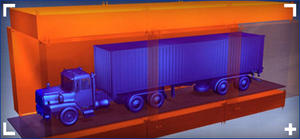Radiation detectionBreakthrough in next gen nuclear detectors
Researchers have long struggled to develop radiation detectors that can spot a nuclear device hidden away in a shielded case, but a recent breakthrough could change all that

MMPDS can detect nuclear material even in shielded containers // Source: decisionsciencescorp.com
Researchers have long struggled to develop radiation detectors that can spot a nuclear device hidden away in a shielded case, but a recent breakthrough could change all that.
Existing passive detectors have limited ranges, while active detectors require large amounts of power and both have difficulty sensing shielded materials. To overcome these challenges, researchers have created the Multi-Mode Passive Detection System (MMPDS) which uses the universe’s constant stream of naturally occurring cosmic radiation.
When a vehicle or container with nuclear material passes between the MMPDS’ sensor arrays, the device will measure the change in the path of muons, high energy particles that have been a constant in the universe since the Big Bang. Denser materials cause greater changes in the paths of muons thereby allowing the sensors to identify the location of nuclear material even if it is shielded by lead and steel.
Since MMPDS is a passive system, it is relatively cheap to construct and operate.
So far MMPDS has successfully undergone initial testing and is currently being deployed at the port of Nassau in the Bahamas as a demonstration.
Developed by Decision Sciences, MMPDS was created largely with private venture capital funding and some assistance from the Los Alamos National Laboratory.
